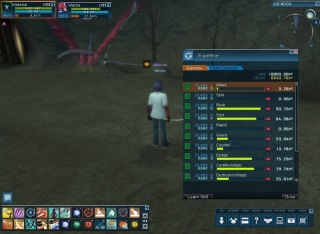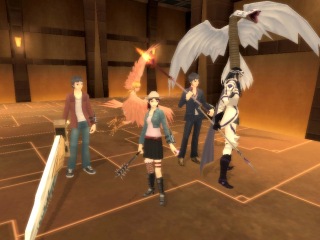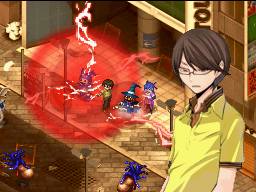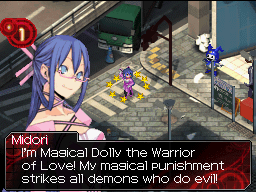
Shin Megami Tensei
Spinoffs
|
Next Page >>> |
|
Page 1: |
Page 2: |
|
|
|
A few years after Atlus unsuccessfully tried to bring SMT to the online world with SMT NINE, they finally released their first MMORPG, subtitled IMAGINE. The story takes place between the events of SMT I &II. Instead of being handled by Atlus themselves, Imagine was developed by Cave, commonly known for their work in the shmup genre. Imagine had been exclusive to Japan for a long time, until Aeria Games, a company specializing in free MMOs, decided to bring the SMT MMO to the US. The playerbase in Imagine are compromised of Devil Busters: humans with the ability to summon demons, tasked with fighting off the demons invading Japan.
At the start of the story, 20XX Tokyo is on the verge of a resurgence. After a summoning ritual went awry, demons began appearing all over the world. Soon after, a nuclear war between Japan and America left most of the world devastated, followed by a giant flood known as the 'Great Destruction'. Many years later, humanity managed to rebuild, with the assistance of a certain group of characters. Humankind was slowly getting back on track, and constructed a gigantic tower in the center of Tokyo as a sign of their resurgence. The appearance of the Obelisks changed all that. Demons began appearing en masse afterwards, which lead to the reforming of the Devil Buster Control Organization.
At the start of the game, the player takes on a role of a new recruit to the Devil Busters. It's here that you meet Snakeman, the commander of Home 3, humanity's primary underground headquarters. Not long after training, events force the player into the world outside Home 3, which is where the game begins.
Much of Imagine takes place in the ruined streets of Japan. The first region, Suginami, is located outside Home 3. Early on during the training, the player gets the first opportunity to decide their stat allocation, given points to distribute between the following stats: Strength, Vitality, Speed, Luck, Magic, and Intelligence.
There's lots of possible combinations, and three primary classes. "Melee" is focused on swords, clubs, and such. Skill benefits include countering, blocking, and special attacks like Dash and Spin. "Gunner" specializes in firearms, while "Mage" specializes in magic, which ranges from attack to restorative to support (stat), or a little of anything. You can try to mix the specialties, but reportedly, you're better off going for a main class, since specialization points are limited.
When a specialization tab is turned on, it lets you start gaining points in that specialization by using that ability. There's a limited amount, so you're warned early on that it's impossible to max out everything. As you gain points, new abilities in those categories become available.
While easy to get the hang of, combat itself can get a little messy. Battle is handled in real-time, via either a point-and-click interface, or keyboard shortcuts. After selecting the ability(such as Attack, Dash, or a certain Spell), clicking on an enemy will hit it with that ability. The most important aspect of Imagine's gameplay is learning how to counter and guard. Most demon attacks can be repelled by a well-timed Counter or Guard stance, but the demons can use these skills as well. In true SMT fashion, most if not all of the monsters encountered on the field can be coerced to your side.
However, Imagine doesn't give the players as many methods as the console SMT games do. At first, the player only has three methods of recruitment at their disposal: variations on the Talk command. Greeting, Threaten, and Taunt each use alternate conversation styles, and get different reactions from different demons. In the early game, this can be a very repetitive activity, since some demons can take repeated conversation to get a positive reaction out of. Most will just leave, some might leave behind an item, and actually getting it to join is the rarest result of all. If the talk skill gains experience, better recruitment abilities are unlocked that let the player bribe the demon, but these can take some time to access, especially if the player is focused on other skill sets.
Once you have a good variety of demons on your side, you can then head to the Cathedral of Shadows to undertake another SMT pastime: fusion. Fusion in Imagine is similar to that of most other SMT games. Fuse two demons, and get a new one, usually with skills carried over from the source demons. Double fusion is all that a single player can perform. Triple fusion requires three participants, one demon from each. The outcomes of fusion vary greatly based on your friendship level with that demon. Since Imagine doesn't allow the saving of demons before fusion, the Cathedral is more lenient than most SMT games with failed fusions. You keep the demons, but you lose your money. However, failure can be a lot more likely if you aren't on good terms with the demons you're fusing.
Demons operate in battle based on AI, but they can be given direct commands with the F1-F10 keys. They tend to operate better with higher care levels. The default is usually 'Contracted', or if fused, commonly "Used like a slave". This can be upgraded by using the Care command (available every 20 hours), or by working together with them in battle and keeping them alive.
The majority of Imagine's plot progression is handled through the Acts. Each one requires the player to complete one or many quests, ranging from finding a key person or item, to taking on a certain dungeon. The dungeons usually have powerful bosses waiting at the end, but the rewards are usually worthwhile, so they're worth taking friends along on. Imagine allows for parties to be formed at any time, with a capacity of five people. Going into dungeons without a party is usually not a good idea. In addition to parties, Imagine also has a clan system. Clans have a capacity of 100 people, and give all the members higher experience bonuses, as well as a means of inter-clan communication, so it's a good way to keep in touch with a lot of fellow Devil Busters.
As with most MMOs, you'll likely encounter the most interesting characters during the story segments. One of the most important factors of Imagine, like any SMT game, is your Alignment. Alignment determines a lot of things. What demons you can summon, how much they will cost you to summon, what equipment you can use, and even the quests you can undertake. Alignment is variable for the most part, but there are moments that require you to make decisions that affect your standing.
The primary warring factions in Imagine are that of Chaos (Gaian) and Law (Messian).
Gaians (Chaos)
Gaians believe in the tenet of 'Might Makes Right', as well as individual freedom. However, their perspective also tends to lead to the suffering of the weak, as well as general anarchy. Their headquarters is in Souhonzan, which can be reached by taking Shinjuku to Ichigaya, and Ichigaya to Ueno.
Messians (Law)
The Messians believe in strict order and a peaceful reign, following the example of their God(commonly associated with the Christian belief structure). The downside of their belief structure is that they cast out all others who do not follow their way of thinking. A Messian lifestyle can be very inhibiting, and does not take those who stray from their path lightly. Their headquarters is in Arcadia, which can be reached by taking Shinjuku to Shibuya, then Shibuya to Arcadia.
Alignment doesn't come into play for a while in Imagine, but it will, so when the time comes, be sure about where you stand.
Other regions of note include Shibuya, which has been affected by one of the three Obelisks, and has become overrun with giant crystals; Nakano, a great forest which began taking over with the appearance of an Obelisk; Ichigaya: the site of the ICBM impact during the Great Destruction which has since been flooded with lava; and Shinjuku Babel, the core city for humanity's resurgence, located at the base of the 666-floor tower of Shinjuku Babel.
SMT Imagine is currently in its open beta. As such, there's a good amount of Engrish and glaring typos to be found. Aeria appear to fixing these errors regularly, which means they might not be around long, so enjoy them while you can.
Quick Info:
|
Developer: |
|
|
Publisher: |
|
|
Genre: |
|
|
Themes: |
Shin Megami Tensei: IMAGINE (Windows)
Shin Megami Tensei: IMAGINE (Windows)
Shin Megami Tensei: IMAGINE (Windows)
Shin Megami Tensei: IMAGINE (Windows)
Shin Megami Tensei: IMAGINE (Windows)
Shin Megami Tensei: IMAGINE (Windows)
Shin Megami Tensei: IMAGINE (Windows)
Shin Megami Tensei: IMAGINE (Windows)
Shin Megami Tensei: IMAGINE (Windows)
Additional Screenshots
Devil Survivor, for being SMT's first outing on the DS, is a pretty big experiment. Few of the series veterans worked on the game. As a rare first, the artwork wasn't done by Kazuma Kaneko or (Persona 3 & 4)'s Shigenori Soejima. Additionally, the music wasn't composed by Shoji Meguro. Still, for a game that's another side story project branching off from the main series, Devil Survivor is pretty damn good.
Although the Japanese version uses the "Megami Ibunroku" tagline (the same as the original Persona), Devil Survivor is a strategy-RPG, more in the lines of Majin Tensei. Graphically, it's a lot like Final Fantasy Tactics, as you move your units across a grid-based battlefield. Each unit consists of three characters - when you get into combat, you enter the traditional Megami Tensei first person battle scene for a round or so of combat. Various factors, including exploiting weaknesses and plain old luck, can grant a character an extra turn. When the leader of the unit is taken down, the whole troupe is destroyed.
Each of the cast in Devil Survivor are amateur devil summoners. They all use COMPs much like in earlier games, only they have the appearance of DS consoles. The story focuses on these group of teenagers, who are blissfully unaware of the existence of the supernatural. Then, demons start appearing, wreaking havoc, and the government locks the city of Tokyo down. The main cast learns they have seven days to either stop the lockdown or find a way out, or else the entire city and all its population will be annihilated to get rid of the demonic invaders.
Quick Info:
|
Developer: |
|
|
Publisher: |
|
|
Designer: |
|
|
Genre: |
|
|
Themes: |
Shin Megami Tensei: Devil Survivor (DS)
Characters
The Protagonist
The nameless hero, named by the player. A 17-year old Japanese student. The introduction informs the player that he will be the one with the will to determine how the situation resolves itself.
Atsuro Kihara
The Protagonist's other close friend. Atsuro is extremely computer-savvy and figures out many of the COMP's functions before anyone else. He will side with the Protagonist regardless of what route he takes.
Amane Kuzuryu
The leader of a mysterious cult called the Shomonkai, all of whom possess COMPs and seek to lead humanity to a law-abiding future. They are extremely similar to the Messian faction in SMT I & II. She will only join the Protagonist under specific conditions.
Keisuke Takagi
A quiet student who takes to devil summoning very quickly after the lockdown, and soon decides to punish the wicked with the demons at his command, even if it means killing them. Keisuke is Devil Survivor's equivalent of a Law Hero, and will join if the Protagonist sees things his way.
Tadashi "Kaido" Nikaido
A foul-mouthed leader of a local gang. Kaido decides to use his demons to hunt down the killer of his brother, who perished in the murders preceding the lockdown. Kaido is Devil Survivor's equivalent of a Chaos Hero, and will join if the Protagonist sees things his way.
In true Shin Megami Tensei tradition, most of the cast have their own opinion on how to resolve the lockdown. Taking their side at key points can lead to Devil Survivor's myriad of potential endings. Among them, he can attempt to destroy the invading military, side with the angelic forces of the Shomonkai, the demonic forces working with Naoya, or simply escape and leave it all behind.
Not all choices simply affect the ending. Early in Devil Survivor, the Protagonist's trio realize they can see a timer above everyone that they meet; a ticking clock which informs the player of when that person will perish. For almost everyone, it says seven days at most, when the lockdown will end. For certain people, it may be shorter, indicating a tragedy's about to befall them. The Protagonist has the option of intervening to save them, or focusing on the main story. Each of the seven days only has a set amount of hours. Time spent talking to people or engaging in story battles will take up half an hour. (The player can engage in "free" battles to gain levels and new demons, which don't take up any time.)
Per usual protocol, devil summoning requires the player to gain the support of other demons. In Devil Survivor, this is done by purchasing them at an eBay-style online auction. The player has to bid a set amount of money to gain a demon. By winning, he can gain new demons into his group. There's also a fusion system to create new ones, but Devil Survivor adds a much needed enhancement to the classic SMT element: inherited skills can be decided by the player, and not subject to a random assortment. However, a demon can only use a maximum of three spells and four enhancement effects, so this isn't quite as effective as it sounds. Still, it makes it much easier to make a killer party, especially since all story characters can have their skills selected the same way. All fusion is done through the Protagonist's COMP, which uses a program variant on the Cathedral of Shadows, so there's no familiar priest helper this time around.
Perhaps reflecting the DS's younger demographic, the character designs are a bit more cartoony than usual. Taken with the light-hearted dialogue in the beginning, it could be easy to mistake Devil Survivor as dumbed down, but once the story gets under way, it's clear that this is classic Megami Tensei. Although all the character art is brand new, longterm SMT fans should recognize the demon designs. They are all taken from older games, and utilize the original artwork of Kazuma Kaneko. For example, Devil Survivor's Angel isn't the BDSM version seen in SMT II and later games, but the original version which appears in a robe. The static battle graphics look very reminiscent of the old Super Famicom games, albeit with a bit more detail. The music is loud butt rock mixed with some electronica, and there's even a catchy J-Pop opening song. It's a pretty good soundtrack, let down by the sparse variety of songs, which you'll hear over and over and over.
It's not without some minor issues - for example, the ally AI for characters you need to protect is astoundingly stupid, and any missions where you need to escort or protect anyone is a huge pain. Regardless, Devil Survivor is a fantastic game, easy one of the best strategy RPGs on the platform, and quality enough to stand aside genre classics like Tactics Ogre. It's also a sizable step up from any of the previous Majin Tensei games. For what's essentially a side-story project, it has a lot of depth crammed into it, and will give an SMT fan lots to occupy their time.
Additional Screenshots
Spinoffs
|
Next Page >>> |
|
Page 1: |
Page 2: |
|
|
|



































